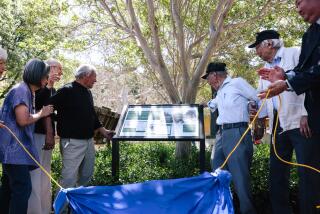Where Ghosts of War Still Walk
- Share via
The thump, thump, thump of the bouncing rubber ball can get annoying while Paul Giacalone is trying to work. But all the assistant director at Drum Barracks Civil War Museum has to do is yell up the mahogany staircase in a firm voice: “I don’t want to hear that ball again,” and the 7-year-old boy complies.
The child is really quite well-mannered--for a ghost.
“He doesn’t know he’s dead,” Giacalone says. “He’s stuck in time, just waiting for his father to come back for him.”
At least, that’s what parapsychologists say. The ball that Giacalone hears, psychics explain, was given to the boy by his father, an officer in the Union Army in the 1860s, when Camp Drum in Wilmington was full of soldiers heading to assignments in the Western Territories. The boy was too ill to travel with his father. He died in the camp hospital about 1868.
Parapsychologists were asked to inspect the old officers’ quarters--the last remaining building from the Union Army camp that once covered 60 acres in New San Pedro (later renamed Wilmington)--when the museum staff noticed items moving around, breezes coming from closed-off rooms--and the thumping noise in the upstairs hall.
Luckily, all the hangers-on from the camp’s Civil War days are friendly ghosts. There’s Col. James Curtis, who prefers the parlor, where he can sit near the fireplace and enjoy the period furniture. “What made believers out of us,” says Giacalone, “is when a lady”--parapsychologist Barbara Conner--”came in and described Col. Curtis to a T.”
For all its ghosts, Drum Barracks--named after Adjutant Gen. Richard Coulter Drum--is also an accredited museum. It opened for public tours in 1987 after a drawn-out battle more fierce than any of the soldiers stationed here had ever fought. It began soon after the building was saved from demolition in the early 1960s.
The Drum museum is now “owned by the state, run by the city and funded by no one,” museum director Marge O’Brien says.
Its library boasts a complete set of the National Archive’s “Official Records of the War of the Rebellion,” documenting daily reports, where the men were stationed and just about every detail of life in the Union and Confederate armies and navies. Many of the museum visitors today are Civil War enthusiasts (including Ken Burns, while he was making his acclaimed PBS documentary “The Civil War”) who take particular interest in the old documents, clothing and photographs.
Though California’s contribution to the war is “just a footnote” in history, the camp was the first building west of the Mississippi specifically built for the Civil War.
As supply depot for the Western Territories from 1862-1871, troops, food and ammunition were shipped from the East Coast, around South America to the Wilmington Depot, named for Phineas Banning’s former Eastern home. Banning and B.D. Wilson owned most of the town and reclaimed the camp’s land after it closed. Banning’s residence, a block from Drum, is also a public museum (see accompanying story).
The tour includes the upstairs rooms, where army gun collections are housed. One of the bedrooms is furnished the way the camp doctor and his wife might have kept it. An Army uniform and other clothing are also on display, including a white party dress chosen because, Giacalone says, “Col. Curtis’ wife Maria is very fond of white . . . we did it for her.”
Drum Barracks, 1052 Banning Blvd., Wilmington. Tours : Tue . -Thur . , 10, 11 a.m. and noon; Sat ., 12:30, 1:30 and 2:30 p.m. Donation , $1; (310) 548-7509.
More to Read
Sign up for The Wild
We’ll help you find the best places to hike, bike and run, as well as the perfect silent spots for meditation and yoga.
You may occasionally receive promotional content from the Los Angeles Times.






